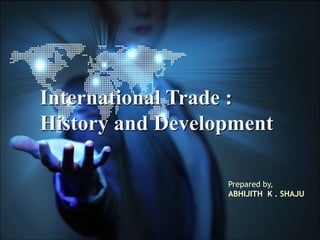
History of International trade -Abhi
- 1. International Trade : History and Development Prepared by, ABHIJITH K . SHAJU
- 2. CONTENTS INTRODUCTION TO TRADE HISTORY OF INTERNATIONAL TRADE EVOLUTION OF TRADE THEORIES TRADE-TRANSPORT DEVELOPMENTS IN TRADE CONCLUSION REFERENCES
- 3. Trade means exchange of goods, services, or both.Trade is also called commerce. Trading is greatly important to the global economy. Trade was also a boon for human interaction, bringing cross-cultural contact to a whole new level. Trade originated in prehistoric times.It was the main facility of prehistoric people, who bartered goods and services from each other.
- 4. There is evidence of the exchange of obsidian and flint during the Stone Age. Materials used for creating jewellery were traded with Egypt since 3000 BCE. Historians believe, the first long-distance trade occurred between Mesopotamia and the Harappan civilization of Indus Valley around 3000 BC. From the very beginning of Greek civilization to the fall of the Roman Empire in the 5th century, a financially worthwhile trade brought valuable spice to Europe from the Far East, including China.
- 5. The fall of the Roman Empire, and the succeeding Dark Ages brought insecurity to Western Europe and a near end of the trade network. The Sogdians ruled the East-West trade route known as the Silk Road from the end 4th century AD to the 8th century AD.(The Silk Road was originally opened up by Zhang Qian and it gradually formed in the Han Dynasty (206 BC-220 AD)) The Vikings and Varangians also traded from the 8th to the 11th century as they sailed from and to Scandinavia. Vikings sailed to Western Europe, while Varangians to Russia. Vasco da Gama restarted the European Spice trade in 1498. Earlier to his sailing around Africa, the flow of spice into Europe was controlled by Islamic powers, especially Egypt.
- 6. Mercantilism (pre-16th century) A nation’s wealth depends on accumulated treasure. Gold and silver are the currency of trade. Free Trade theories(17th-18th century) Absolute Advantage (Adam Smith, 1776) Comparative Advantage (David Ricardo, 1817) Neo classical Theories: Heckscher -Olin Theory(1919) Product Life Cycle Theory New Trade Theory Porter’s Diamond 19th Century: British colonialism based on the principles of liberalism. European states forcing for trade in Africa, India, Southeast Asia and Latin America.
- 7. The first ‘long-distance’ trade occurred between Mesopotamia and the Indus Valley in Pakistan around 3000 BC, historians believe. In the absence of proper roads, the most efficient way to transport goods from one place to another was by sea. The first and most extensive trade networks were actually waterways like the Nile, the Tigris and the Euphrates in present-day Iraq and the Yellow River in China. Cities grew up in the fertile basins on the borders of those rivers and then expanded by using their watery highways to import and export goods. The domestication of camels around 1000 BC helped encourage trade routes over land, called caravans, and linked India with the Mediterranean.
- 8. The invention of money has made trade simpler. Today traders generally negotiate through the medium of exchange, like money, which then makes buying separate from selling, or earning. GATT was designed by the UN in 1946 aimed to increase trade by tariff reduction. Later, World Trade Organization (WTO) established in 1995, (global international organization dealing with the rules of trade between nations). As transportation has become increasingly less expensive and telecommunications have improved,hence international trade has flourished.
- 9. By understanding international trade, we will uncover one of the most important real life applications of macroeconomics. The importing and exporting of goods is big business in today's global economy and it balances the Nation’s Economic stability. Dumping should be prevented. The process of trade should favour the nation’s growth.
- 10. Dominick Salvatore, International Economics, John Wiley & Sons Inc., 2004. Krugman,Paul R. and Obstfeld, Maurice (2005).International Economics: Theory and Policy,7th edition, Boston: Addison-Wesley. Pdf files : LECTURE NOTES in INTERNATIONAL TRADE POLICY (*) Cevat Gerni Beykent University/İstanbul 2010. James R. Markusen, An Introduction to International Trade Theory, 2006,January 9-20,University of Colorado, Boulder.
